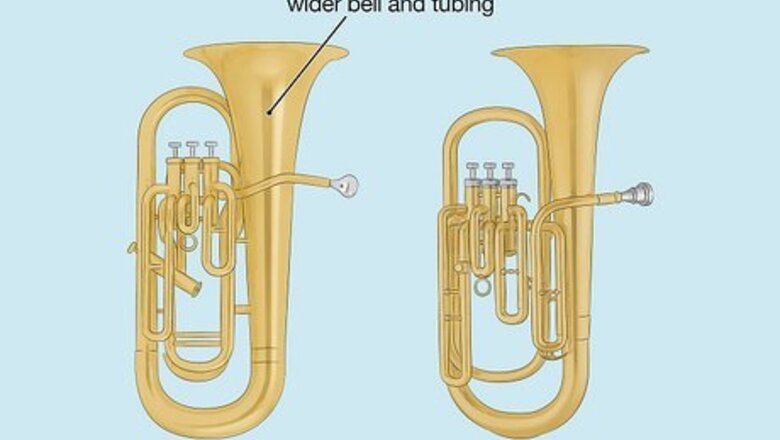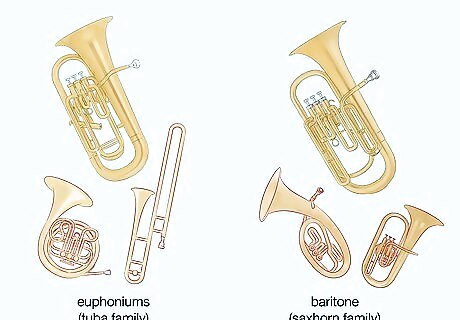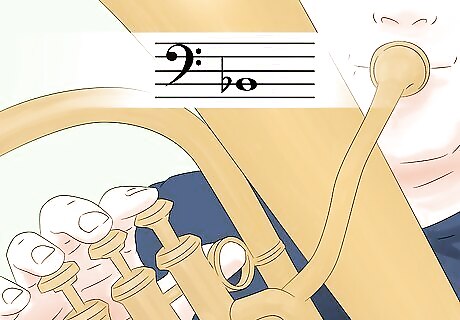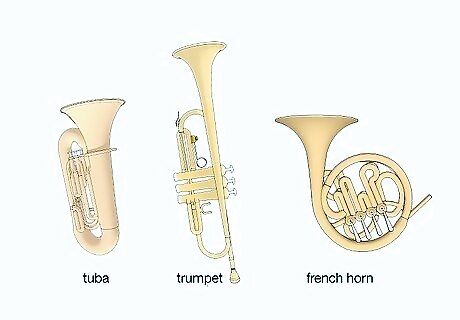
views
- Euphoniums and baritones are both brass instruments, but euphoniums are in the tuba family, while baritones are part saxhorn.
- Baritones have cylindrical tubing and narrow bells, whereas euphoniums have conical tubing and wide bells.
- A euphonium and baritone are both low-pitched instruments that mainly produce B♭ notes.
Differences

A euphoniusm has a wider bell and tubing than a baritone. Not only is this a physical difference, but it also results in different sounds. The euphonium’s tubing extends past the piston valves and has a conical shape and wide bore, which produces a fuller and rounder sound. Meanwhile, a baritone has cylindrical tubing that’s narrow before the bell and stops at the valves, resulting in a brighter and more focused sound. Think of it this way: baritones sound like “eh,” while euphoniums have an “uh” sound. A musician must place their hand underneath the tubing to play the euphonium. Some musicians debate that a euphonium is more challenging to play because of its larger bell. But, above all, it does make the instrument heavier than the euphonium.

Baritones are part of the saxhorn family, while euphoniums are in the tuba family. An instrument’s class determines its sound, shape, and place in an orchestra. Because of its low-pitch, conical bores, and deep-cup mouthpiece, a baritone is a member of the saxhorn family. A euphonium, on the other hand, is part of the tuba family thanks to its extremely low pitch and wide bell. Many would argue that euphonium is a class of its own in the brass family, while others agree it falls in line with the tuba.
Similarities

Euphoniums and baritones originate from the serpent horn. A baritone and euphonium look and sound similar because they have similar origins. They both originate from the 1500s bass wind instrument, the serpent. This instrument is still played today and is made of 8 feet (2.4 m) long wooden tubing, has a conical bore, and produces a low, full note. The serpent was invented long before the euphonium and baritone, which were created in the 1840s. Euphoniums and baritones are not typically used in classical compositions or played in orchestras because they’re a relatively new invention.

Baritones and euphoniums have a B♭ pitch. These brass instruments both have very low pitches. Because of this, they’re considered transposing instruments and can be written with bass or treble clefs. Transposing instruments can be played interchangeably, and their written music shows relative pitches (or reference tones) rather than exact pitches.

Euphoniums and baritones are made of 9-foot tubing. Despite their differences in width and size, these instruments are both created with the same length of tubing. This is why and how they have identical tonal ranges, even with their different-sized bells.
When are baritones and euphoniums used?

Baritones and euphoniums are commonly used in brass, marching, and military bands. Because they’re a new instrumental invention, euphoniums and baritones aren’t typically seen in traditional orchestras. However, these brass instruments are often found in concert or local community bands where brass instruments and percussion unite. Euphoniums and baritones may not be widely used in orchestras, but that doesn’t mean they can’t make an appearance, especially if modern music is being played.
Do other instruments sound like the euphonium and baritone?

The instruments within the brass family have similar sounds to the euphonium and baritone. There’s a reason these instruments are commonly placed side-by-side in an orchestra—because they have similar pitches and ranges. Not only do these brass instruments sound nearly identical, but they look similar as well! Here are some other brass instruments related to the euphonium and baritone that you may be familiar with: Tuba, which ranges from F to B♭. Trumpet, which is an octave above the euphonium and baritone. French horn, which can also play from F to B♭.















Comments
0 comment